The Eta Carina Nebula (NGC 3372)
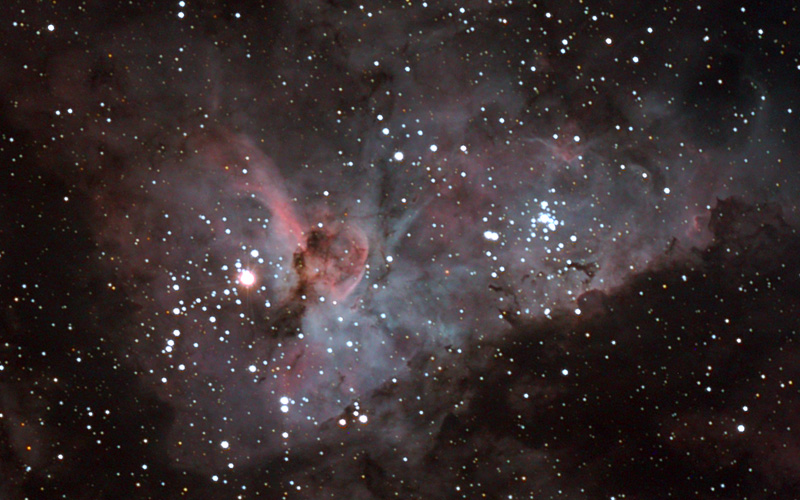
The above image shows the Keyhole Nebula (the reddish central blob) within
the Eta Carina Nebula. The star designated as Eta Carina is the brightest star next
to the Keyhole nebula. The red light is from Hydrogen Alpha (H-alpha) emissions and
the blue light is from a combination of O-III and H-beta emissions combined with Rayleigh
scattering of (sky blue) light as it makes its way through this very dusty area.
May 2016
Eta Carina closeup 8-inch Ritchey
Chretien Off axis guided; Canon 350D (mod) EQ-6 mount
Full Frame Version (Very big file)
March 2016
Eta Carina (close-up)
8-inch Schmidt Newtonian; MPCC; Canon 350D
(mod)
April 2011
Eta Carina (Hydrogen-Alpha) Orion
80mm ED Refractor; H-a filter; Canon 350D (mod); EQ-6 Guided
March 2009
March
2009 Eta Carina (close-up) 80mm Refractor 42x1 mins 1600ISO EQ-6
guided
March
2009 Eta Carina (wider) 80mm Refractor 42x1 mins 1600ISO EQ-6
guided
March
2009 Eta Carina (widest) 80mm Refractor 42x1 mins 1600ISO EQ-6
guided
Other Favorite images
26Jan09
Eta Carina widefield 200mm lens IDAS filter 48x2mins ISO1600 EQ-6
Guided
Eta
Carina closer 26Jan09 200mm lens IDAS filter 48x2mins ISO1600 EQ-6
Guided
April 2008
05Apr08
Eta Carina SN-8 MPCC UHC-S 59mins ISO1600 - rework (the best image so far)
05Apr08
Eta Carina SN-8 MPCC UHC-S 59mins ISO1600 - rework (the best image so far - slightly
wider)
05Apr08
Eta Carina SN-8 MPCC UHC-S 59mins ISO1600
05Apr08
Eta Carina SN-8 MPCC UHC-S 48mins ISO1600 - Very Nice
05Apr08
Eta Carina SN-8 MPCC UHC-S 48mins ISO1600 - Widefield
05Apr08
Eta Carina SN-8 MPCC UHC-S 48mins ISO1600 - South East
Eta
Carina (Grayscale) - Widefield
March 2008
10Mar08
Eta Carina (UHC-S 11mins and MPCC 18mins combination Close-up Poster)
10Mar08
Eta Carina (UHC-S 11mins and MPCC 18mins combination Wider Poster)
2006
Jun2006
As Published in Australian Sky and Telescope Magazine
26Mar06
Eta Carina 28x30sec (Reworked from old data. Hand selected subs) WOW!!!
27Apr06
Eta Carina 44x30sec East Arm closeup MPCC (1024x768)
27Apr06 Eta
Carina 44x30sec MPCC (1024x768)
27Apr06 Eta
Carina 44x30sec MPCC (1280x1024)
27Apr06 Eta
Carina 44x30sec MPCC (closeup) (1280x1024)
16Apr06
Eta Carina Test of Baader MPCC Coma Corrector 4x60secs
26Mar06
Eta Carina 28x30sec WOW!!!
26Mar06 Eta
Carina full frame 46x30 secs
26Mar06 Eta
Carina full frame 46x30 secs
26Mar06 Eta
Carina medium crop 46x30 secs
26Mar06
Eta Carina close crop Dust Clouds (red color balance)
26Mar06 Eta
Carina close crop Brightened (see sky cracks)
26Mar06
Eta Carina Color Balanced Exactly in "Canon Digital Photo Professional"
(1280x1024)
26Mar06
Eta Carina Color Balanced Exactly in "Canon Digital Photo Professional"
(800x600)
26Mar06
Eta Carina Color Balanced Exactly in "Canon Digital Photo Professional"
(1280x2190) BIG !
25Feb06
Prime Focus Cropped Closeup of Keyhole Nebula
The Eta Carina Archive (of really old
embarassing images)
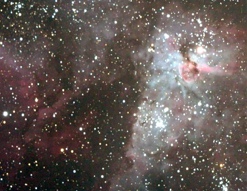
Eta Carina Prime Focus
|
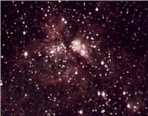
Mintron Camera
on a Barn Door mount
|
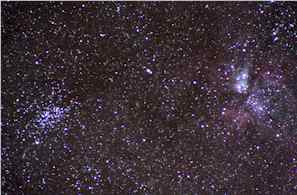
NGC 3532 Canon 350D piggyback
on LXD-75
|
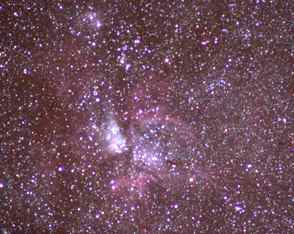
Canon 350D piggyback
on an LXD-75 mount
|
The Eta Carina region is a rich part of the sky which because of its
southern latitude isn't so well heard of but it is deserving of the closest observation
and study. At the centre of the nebula is the unusual star that gives the nebula its
name, Eta Carina. The star's brightness has varied wildly over the few
centuries that it has been studied. In 1843 it was the second brightest star in the
sky. In the early 1900s it was invisible, but since then it has slowly increased in
brightness and is visible again.
The last time it brightened significantly was in 1989. The star
appears to hiccup at irregular intervals without actually blowing itself apart in a
supernova. The last time this happened was in 1843 when it ejected huge quantities
of material in a massive explosion. By ejecting these huge amounts of material and
energy into the surrounding space it is creating nebulosity in its general area. Eta
Carina is possibly the brightest star and most massive star in our entire galaxy.
Its mass is 100 times that of our sun. Its luminosity more brilliant by 4
million times. Its diameter is the same as our entire solar system.
In the centre of the Eta Carina nebula (NGC 3532) is the Keyhole nebula
(NGC 3324). In the right light it really looks like a keyhole. A nebula within
a nebula. This is where the star itself is located, together with several of the
most massive and energetic suns known to science.
Eta Carina is situated in a bright part of the Milky Way, so viewing it
through a telescope or photographing it yields not just a nice picture of its nebulosity
but also of one of the richest Milky Way star fields as well. Only the Sagittarius
starfield, I believe, is more densely packed with little stars.
Back to see more Nebulas
|

